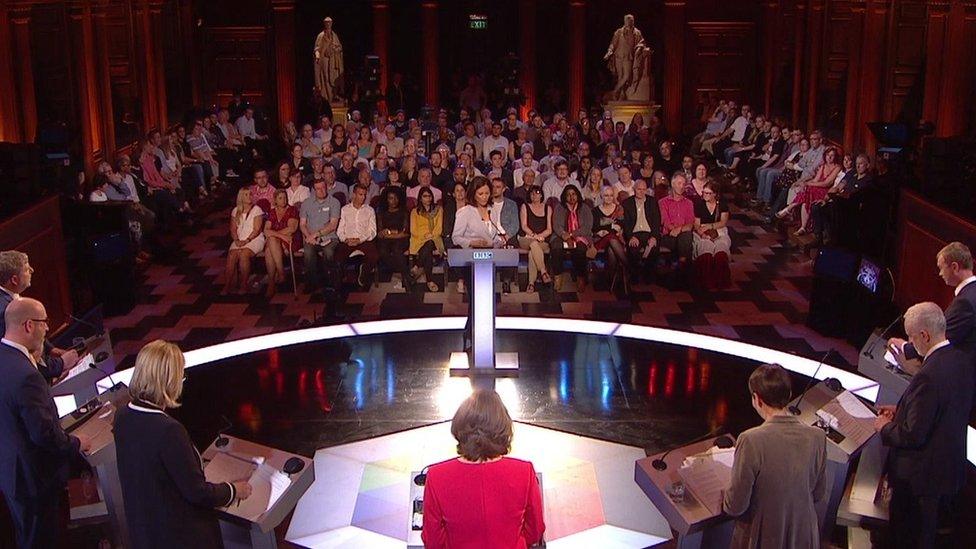BBC election audience 'rigorously' selected - ComRes
- Published

The polling company chosen to select the audience for the BBC's election debate has defended its political make-up amid claims of "left-wing bias".
Andrew Hawkins, founder of ComRes, said the recruitment of people to watch the seven-way debate had been "more complex" than he had ever witnessed.
He said five of the parties were left of centre - which meant "cheering is going to be skewed in one direction".
But Boris Johnson said the debate was an "echo chamber for left-wing views".
Former UKIP leader Nigel Farage agreed, tweeting: "The BBC audience was full of left wingers tonight."
George Eaton, political editor of the left-leaning New Statesman also tweeted: "This feels like [the] most left-wing audience in any election debate."
The set-piece event, which took place in Cambridge, featured Labour's Jeremy Corbyn, Lib Dem leader Tim Farron, UKIP's Paul Nuttall, SNP deputy leader Angus Robertson, Green co-leader Caroline Lucas and Plaid Cymru's Leanne Wood.
Conservative leader Theresa May came in for some criticism for refusing to take part in the debate, with Home Secretary Amber Rudd taking her place.
The BBC said it commissioned ComRes to recruit an audience that was "representative of the country demographically and politically" and this included: age, gender, ethnicity, socio-economic factors, party politics, how they voted in the EU referendum and some who had been undecided.
Politicians from seven parties were questioned about leadership
General election 2017: Rudd and Corbyn challenged on costs
During the debate there was cheering and booing which led some, including Foreign Secretary Boris Johnson, to suggest the audience was biased.
Mr Johnson told BBC Breakfast: "It was seven people speaking to probably the most left-wing studio audience the BBC has ever brought together."
But ComRes founder Mr Hawkins told BBC 5 live a lot of thought had gone into the audience selection.

155 people recruited for audience of 134
Two-phase online and telephone approach to recruitment
Audience members selected using detailed questionnaire designed by ComRes and approved by BBC
Adults who campaigned at any election from 2014 filtered out
Conservative and Labour had the largest share of supporters in the room
Smaller parties supported by appropriately lower number
50:50 split of Remain and Leave voters at EU referendum
Audience members contacted by phone and rescreened on key questions to ensure consistency with previous answers

Mr Hawkins said: "If you have a panel of people - one from the governing party (Conservatives) - one from what's regarded as a right wing party (UKIP) and five from broadly left-wing parties, and you give those speakers equal airtime, it means you're giving five slots of airtime to the left-wing parties for every two slots to the not so left-wing parties.
"Therefore it's inevitable that the cheering is going to be skewed in one direction.
"What I can say is that the recruitment for this was more complex and more rigorously executed than any I've ever witnessed."
He said Brexit had added an extra layer of complications to the selection process because an equal number of Leavers and Remainers had to be chosen.
"We screened out people who have campaigned politically at any time in the last three years," he said.
"But equally, you need to get people who are politically engaged so the audience don't sit there and say nothing and do nothing, so you do get some reaction."
Mr Hawkins said the audience response was "a reflection of the fact that the Conservatives were on the back foot because Theresa May didn't turn up - and therefore it's a bit of an easy target".
The reaction of the audience during Wednesday night's televised debate was in contrast to the first ever UK General Election TV debates, from 2010, when the audience was not allowed to applaud, external during the programme, only at the beginning and end.